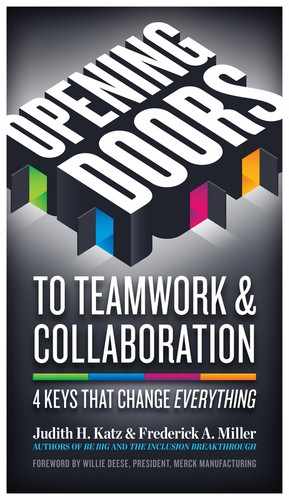Opening the Door to …. COLLABORATION
Key #2: Listen as an Ally

CORE BEHAVIORS TO COLLABORATION
Listen as an Ally
![]() LISTEN AS A PARTNER:
LISTEN AS A PARTNER:
be ready to join the other person—and give the person the benefit of the doubt.
![]() LISTEN FULLY:
LISTEN FULLY:
respond with nonverbal communication as well as words, and check in with the speaker to confirm you understand what is being said.
![]() GIVE ENERGY BACK:
GIVE ENERGY BACK:
engage in a spirit of building on what was said.

Allies are willing to work
a little harder to hear,
understand, appreciate,
and build on others’ ideas.
Are you willing to
Listen as an Ally?
Are we all in this together?
“Are we all in this together?” should not be the first question that comes to my mind as I start my workday because it shouldn’t be a question at all. The knowledge that we are all in this together to achieve common goals should be the basis for all my interactions, decisions, and actions throughout my day at work, every day. It should be the foundation—the given.
But in too many organizations, people have a very narrow sense of “we.” Often it is more like us versus them. And when we ask if we are all in this together, people have different ideas about what this refers to. Instead of a shared sense of purpose and joint effort, there are conflicting priorities and competition for information, attention, and advantage. And even together doesn’t feel like reality. Too often, these words sound less like a genuine question and more like pie-in-the-sky sentiment that prompts eye-rolling and gets ignored, especially when it is not tied to a reward system or how people really work in the organization. People and organizations may say they are all in this together, or even aspire to be so, but it definitely isn’t how they act.
So before we can open the door to collaboration—before we can even want to open the door to collaboration—each of us needs to answer that simple question: are we all in this together?
Collaboration at times has been used to describe something traitors did with the enemy. And in many organizations, it is still treated that way. In too many organizations, too many people …
![]() criticize colleagues to promote their own positions.
criticize colleagues to promote their own positions.
![]() hoard information to reinforce power and keep ahead of others.
hoard information to reinforce power and keep ahead of others.
![]() keep their ideas to themselves to avoid criticism.
keep their ideas to themselves to avoid criticism.
![]() define their immediate work team as part of their “we,” but rarely extend that “we” to include people outside that team or in another division or department.
define their immediate work team as part of their “we,” but rarely extend that “we” to include people outside that team or in another division or department.

When I look at you as outside
of my “we,” I am quick to
judge you, reluctant to
join you, and rarely give
you the benefit of the
doubt. I keep the door to
collaboration closed.
Without a sense of “we,” it is impossible to achieve …
![]() shared purpose.
shared purpose.
![]() shared effort.
shared effort.
![]() shared excitement.
shared excitement.
![]() shared success.
shared success.
Creating a “We”: A Community of Effort
When United Airlines was reinventing itself out of bankruptcy, its former CEO Glenn Tilton said, “We have to create a Community of Effort to succeed.”
A Community of Effort is an extended sense of “we”—the sense that yes, we are all in this together. And getting there requires one to Lean into Discomfort and move beyond the boundaries of the self and the cubicle.
It means moving from a judging mindset to a joining mindset with our work colleagues.
It means …
![]() seeing them as our partners.
seeing them as our partners.
![]() seeing them as friends and allies.
seeing them as friends and allies.
![]() seeing them as people who are on the same side of the table, not the opposite side.
seeing them as people who are on the same side of the table, not the opposite side.
It means expanding the boundaries of our comfort zones and extending trust to welcome the fresh perspectives and energies of new team members. It means seeing different perspectives as opportunities and energy toward solving problems, not as oppositional.
It means building cooperative, collaborative, mutual working relationships by linking our ideas together to create something better than any of us could have done individually.
Yes, but before I can expect to build a community with worthy allies, I have to know what it means to be a “we,” to be a partner, to be an ally—and be willing to be one.
And before I can experience the sense that we are all in this together, I need to want to be part of something bigger than myself and to help create a new sense of “we.”
But often is it difficult to create a “we” and to Listen as an Ally…
I get the memo announcing the time and agenda for today’s staff meeting and I groan. I can’t help myself. Most of my colleagues feel the same way about our staff meetings. We talk about them as “boring,” “painful,” and a “waste of time.”
When I get to the meeting, Clarice starts talking about her project, and I start tuning out. She is not in my work group, so I have little interest in her report. I wasn’t asked to contribute, so why should I pay attention? Her area is different from my area of expertise, so I am not sure that she would be interested in what I might have to contribute anyway. And besides, I have my own report to give, and I am mentally rehearsing my presentation while trying to assess my manager’s mood today.
Meanwhile, sitting next to me, another colleague, Ajay, is excitedly squirming in his seat. He doesn’t have a report on the agenda today, but he has good news about a development that is likely to please our leader, and he is looking for an opportunity to speak. He is not really listening to Clarice either. He is waiting for her to finish or to pause for breath so he can jump in and share the news.
As Clarice continues her presentation, others around the table interrupt her with questions about possible shortcomings and flaws:
“Did you run this through legal?”
“Did you consider how our affiliates might react?”
“Have you researched what our competition is doing about this?”
“On slide 20, I think you could have said that a better way.”
“I think you are wrong about your eighth point.”
As I watch Clarice’s confidence erode, I realize my report is scheduled next. Uh oh! After the comments Clarice got, I am not looking forward to being the next person on the chopping block.
But when people see themselves as a “we” and Listen as Allies …
I smile when I get the memo about the meeting. I am looking forward to getting together because the meetings are lively and engaging. Everyone leans into the conversations and wants to contribute. When we are together, real progress is achieved, good things usually happen as people build on each other’s ideas, and the outcome is greater than any one individual’s contribution.
When Clarice starts talking about her project, I listen attentively and with interest. Her work group is accomplishing important things for the organization, and I think of ways I can support them as well as how that work might impact me and my team’s work.
My responses and questions and those from others around the table focus on clarifying and improving our understanding of her team’s work and finding the connections to what our teams are doing to ensure alignment across our different groups. And while my work group’s professional discipline is different from hers, I think my different perspective might be useful.
When Clarice finishes her report, I mention that something my work group has been working on might help her work group make their process more effective. She asks for details. Others around the table offer examples and suggestions from their own areas that make the collaboration sound especially promising. Before moving on to the next agenda item, team members express their appreciations for what she and her team shared and what they each learned as a result of the conversation.
As Clarice sits down, I can see that she feels her contribution made a difference to the group. She felt heard and came away with some promising new avenues to pursue in continuing the project.
And now that it is my turn to present, I feel energized and eager to share my report with the team with the anticipation that new doors will open through our conversation.
Just another ordinary staff meeting. But what a difference!

I assume that
if something
is important or
of interest to
you, it will be of
interest to me.
Like a Friend
The concept of Listening as an Ally came out of a workshop we were giving for leaders of a change initiative in a large multinational organization.
We were discussing the importance of listening and the differences in the ways we listen to our friends versus people we do not see as friends. With friends, we are ready from the outset of an interaction to join with them, assume positive intent, work a little harder to understand their points of view, support them, second their ideas, and build on their ideas.
When we pointed out how rare it is for people in organizations to listen to others as supportively as they do to their friends, one of the participants said, “Well, this may require me to Lean into Discomfort just a little, but from now on, I am going to listen to everyone as a friend!”

If you succeed,
it is good for me too!
To Listen as an Ally means …
![]() listening to find value rather than to find flaws.
listening to find value rather than to find flaws.
![]() assuming good intent, even if there are flaws or missteps.
assuming good intent, even if there are flaws or missteps.
![]() taking the time to put in the effort to hear and understand fully what is being shared.
taking the time to put in the effort to hear and understand fully what is being shared.
![]() checking in with the speakers to find out if our understanding is correct—to let them know what we heard and to let them know that they have been heard.
checking in with the speakers to find out if our understanding is correct—to let them know what we heard and to let them know that they have been heard.
![]() listening from a learning posture instead of getting ready to respond or interrupt.
listening from a learning posture instead of getting ready to respond or interrupt.
![]() starting with an assumption that we can connect and work to find the places of connection.
starting with an assumption that we can connect and work to find the places of connection.
![]() listening with the intent to join, offering appreciation, and contributing to the interaction.
listening with the intent to join, offering appreciation, and contributing to the interaction.
Listening as an Ally Enables the Discovery of Common Interests
We each play roles in our team’s and our organization’s success, so things that affect either of us should be of interest to both of us.
When I start with the assumption that I want to interact with my team members or other teams as allies—that we want to open the door between us and join our efforts—then each of us will be more willing to reveal what we are thinking, and we all benefit.
Listening as an Ally Enables Us to Find Our Common Good
Often people say they are working for the common good and shared success, but in reality they have conflicting objectives or see the priorities in a different order. This often leads to beneath-the-surface conflicts that are rarely identified or addressed and can get in the way of higher performance.
When we each Listen as an Ally, we work together to get underneath our assumptions, identify and work through our conflicts, and construct an aligned image of what shared success looks like.
Listening as an Ally Enables Us to Link Our Ideas, Thoughts, and Feelings
I can foster collaboration by linking to another’s ideas and acknowledging other’s contributions.
When I build on someone else’s idea rather than rejecting and offering an alternative to it, it shows I recognize value in that idea. It encourages others to combine energies to achieve collective success instead of competing against each other to achieve individual success at the expense of the team.
And it can be as simple as substituting the words “Yes, and …” for the words “Yes, but …”
When I link to someone’s thoughts and feelings as I Listen as an Ally, it lets that person know, “Yes, you have been heard.”
Yes, and …

Listening as an Ally Enables Us to Give Energy Back
When I acknowledge someone’s hard work, courage, or innovative idea, it encourages a repeat performance and a greater investment of energy and effort the next time. Verbally appreciating others’ contributions gives energy back by providing feedback and letting them know how they made a difference to me. This helps build our connection. It encourages the sense of a Community of Effort in which all of us recognize and support each other’s contributions.
Giving energy back to you makes you feel more valued and engaged. We can give energy back by …
![]() calling out the parts of what was shared that we would underscore.
calling out the parts of what was shared that we would underscore.
![]() being specific about the parts we found most helpful, and why.
being specific about the parts we found most helpful, and why.
![]() sharing what we learned and the insights we took away.
sharing what we learned and the insights we took away.
![]() giving thanks for the person’s thinking, time, energy, and contributions to moving things forward.
giving thanks for the person’s thinking, time, energy, and contributions to moving things forward.
Giving energy back enhances
our interactions, reinforces
partnership, and builds
a community of allies.
Listening as an Ally Is Not about Sugarcoating or Avoiding the Truth
When I Listen as an Ally, I need to be honest and convey authentic, useful feedback. I show my respect for you by giving you my true perspective, which I assume you will appreciate more than some sugarcoated response.
And when I am in meetings or gatherings of colleagues where Listening as an Ally has not been the normal way of interacting, I may not find it safe or comfortable at first. It may require me to Lean into Discomfort.
But think about it like this: when you are talking to someone, would you like that person to Listen as an Ally? If so, it’s time for you to Listen as an Ally to others.
Seeking clarification and shared understanding will improve the communication in the room for everyone.
When you Listen as an Ally to one person, there is a benefit to all.
Listening as an Ally Also Means to Challenge as an Ally
When we Challenge as an Ally, we provide new ways of thinking and seeing what was presented in the spirit of an ally, not a judge. We offer alternative perspectives, approaches, and solutions without the claim that they are more valid than the original thought—only that it might add some value from another perspective or Street Corner.
When we each Challenge as an Ally, we are partnering—seeing ourselves on the same side of the table—and seeking ways to help enhance what has been said or done, not to detract from or diminish it.
When we fail to Challenge as an Ally—whether by not expressing options for enhancement, attacking what is being shared, or avoiding engagement—we pay a price: we all end up with less.
If each of us doesn’t Challenge as an Ally …
![]() I may leave thinking that everything I presented was fine, but my team members may feel that what I shared was missing the mark. However, I will not know that and will therefore not perform as well as I could.
I may leave thinking that everything I presented was fine, but my team members may feel that what I shared was missing the mark. However, I will not know that and will therefore not perform as well as I could.
![]() I might think that I just wasted my time and that my team members don’t care or are not invested in my or our team’s success because we failed to engage.
I might think that I just wasted my time and that my team members don’t care or are not invested in my or our team’s success because we failed to engage.
![]() I may feel attacked, diminished, or threatened (instead of supported and challenged) and will be less likely to make the effort to present my fullest or most creative ideas in the future.
I may feel attacked, diminished, or threatened (instead of supported and challenged) and will be less likely to make the effort to present my fullest or most creative ideas in the future.
And if I am not
challenged at all,
learning opportunities
are lost.

Overcoming the “No, No, No!” Reaction
Sitting in a product development meeting, a leader, Sarah, listens as one of her team members makes a suggestion for a new product that is way out of line with the types of products they have been developing. Internally, her first response is, “No, no, no! There is no way that will work.”
Instead, Sarah decides to Listen as an Ally—she encourages the team member to say more. As other team members listen, they get excited. Sarah invites them to share their opinions about the possible new product and how they could make that work. Team members build on each other’s ideas and explore where the ideas take them.
After much conversation, the group concludes that the original suggestion is not workable, but as a result of their conversation the team identifies several new options.
If Sarah had gone with her initial “no” response, the idea would have been shot down and the team’s thinking would not have evolved. Because Sarah was able to Listen as an Ally and engage with curiosity and encouragement, she enabled an outcome that otherwise would not have been imagined.
So what’s stopping us from wanting to Listen as an Ally?
“We have to maintain our standards.
How can we maintain quality if we
can’t ask the hard questions?”
“Nobody around here acts that way.
We are all grown-ups here. We don’t
need to listen in any special way.”
“I really don’t have time to listen. If I give you
an opening, you may go on and on all day.”
![]() Sometimes we are so focused on thinking about what we want to do or say that it is difficult to slow down enough to listen fully to what someone else has to say. To Listen as an Ally takes patience, and we are often in a hurry. But there is a huge cost when we have to rework and revisit discussions because we haven’t fully listened and engaged. If each of us doesn’t take the time to Listen as an Ally, we can miss important information that will impact our ability to achieve our goals in a timely manner. Sometimes it’s best to slow down in order to speed up.
Sometimes we are so focused on thinking about what we want to do or say that it is difficult to slow down enough to listen fully to what someone else has to say. To Listen as an Ally takes patience, and we are often in a hurry. But there is a huge cost when we have to rework and revisit discussions because we haven’t fully listened and engaged. If each of us doesn’t take the time to Listen as an Ally, we can miss important information that will impact our ability to achieve our goals in a timely manner. Sometimes it’s best to slow down in order to speed up.
![]() Some people worry that if they Listen as an Ally, they won’t be able to express disagreement or say things that are difficult to say. When we Listen as an Ally, we start by looking for the value in what others have to offer, but we would not be good allies if we ignored the flaws and errors and ways to improve on what was offered. To Listen as an Ally does not mean one lowers standards or avoids conflicts. To Listen as an Ally, one must Challenge as an Ally, but it must be done with respect and in the spirit of true joining.
Some people worry that if they Listen as an Ally, they won’t be able to express disagreement or say things that are difficult to say. When we Listen as an Ally, we start by looking for the value in what others have to offer, but we would not be good allies if we ignored the flaws and errors and ways to improve on what was offered. To Listen as an Ally does not mean one lowers standards or avoids conflicts. To Listen as an Ally, one must Challenge as an Ally, but it must be done with respect and in the spirit of true joining.
![]() If we want a higher-performing team and greater collaboration, maybe it’s time to listen to our colleagues, one of the most important things we can do. Fundamentally, every person wants to feel listened to. That is one of the most important things we can do for our team members.
If we want a higher-performing team and greater collaboration, maybe it’s time to listen to our colleagues, one of the most important things we can do. Fundamentally, every person wants to feel listened to. That is one of the most important things we can do for our team members.
Present to Us Again, Sam
His last presentation to the Senior Leadership Group several months ago had been so upsetting that Sam vowed he would not do another one. At that meeting the leaders sat with their laptops open and either attacked the presentation or paid more attention to their emails than to Sam. Since that time, many of his best ideas were never shared. But Sam had heard that things had changed. Leaders were focusing on modeling new behaviors and had made a commitment to Listen as an Ally and to give energy back.
Sam, however, did need to give another presentation. Upon walking into the room, Sam noted a difference in the leaders’ behaviors. He was greeted by name and people shook his hand. Laptops were closed and phones out of reach. As he shared his presentation, people actively listened and appreciated his work and his ideas. When he was done, people linked to his ideas and talked about what they learned from his presentation and appreciated about it. They offered improvement suggestions about areas for further exploration and enhancement. Although they had questions and comments about the project, they discussed it as allies, building on Sam’s ideas rather than attacking them.
Sam left the meeting energized to continue his work on this project, feeling he had the backing and support of the leadership team.
Checklist for Listening as an Ally
![]() Let others know you need them to Listen as an Ally as a way to signal that you need their full attention.
Let others know you need them to Listen as an Ally as a way to signal that you need their full attention.
![]() Give your full attention to others when they are speaking. Don’t multitask.
Give your full attention to others when they are speaking. Don’t multitask.
![]() Make eye contact and ensure your body language is giving the message “I am joining with you as a partner.”
Make eye contact and ensure your body language is giving the message “I am joining with you as a partner.”
![]() Restate what you have heard to check that you are receiving the intended message. Use clarifying questions and language that seeks to understand, such as “Let me check that I understand” and “What I heard you saying was …”
Restate what you have heard to check that you are receiving the intended message. Use clarifying questions and language that seeks to understand, such as “Let me check that I understand” and “What I heard you saying was …”
![]() Accept that what others are saying is true for them and that their perspectives (their Street Corners) may be different from yours but no less valid.
Accept that what others are saying is true for them and that their perspectives (their Street Corners) may be different from yours but no less valid.
![]() After having listened actively, deeply, fully—and making sure you understand their meaning from their point of view—engage with the speakers by respectfully and honestly sharing what you heard as an ally.
After having listened actively, deeply, fully—and making sure you understand their meaning from their point of view—engage with the speakers by respectfully and honestly sharing what you heard as an ally.
![]() Express your appreciation for what was shared. Give energy back!
Express your appreciation for what was shared. Give energy back!


